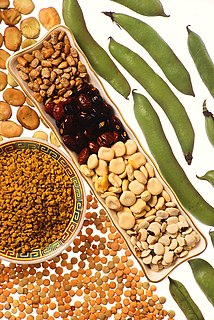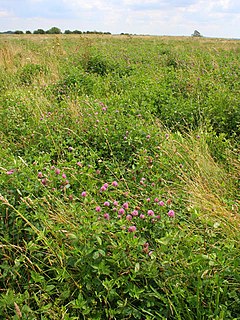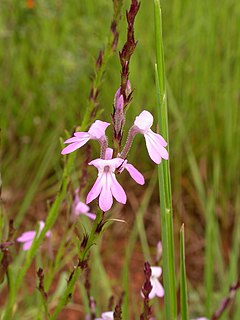Related Research Articles

Quinoa is a flowering plant in the amaranth family. It is a herbaceous annual plant grown as a crop primarily for its edible seeds; the seeds are rich in protein, dietary fiber, B vitamins, and dietary minerals in amounts greater than in many grains. Quinoa is not a grass, but rather a pseudocereal botanically related to spinach and amaranth, and originated in the Andean region of northwestern South America. It was first used to feed livestock 5,200–7,000 years ago, and for human consumption 3,000–4,000 years ago in the Lake Titicaca basin of Peru and Bolivia.

Eragrostis tef, also known as teff, Williams lovegrass or annual bunch grass, is an annual grass, a species of lovegrass native to the Horn of Africa, notably to modern-day Ethiopia. It is cultivated for its edible seeds, also known as teff. Teff was one of the earliest plants domesticated. It is one of the most important staple crops in Ethiopia and Eritrea.

A legume is a plant in the family Fabaceae, or the fruit or seed of such a plant. When used as a dry grain, the seed is also called a pulse. Legumes are grown agriculturally, primarily for human consumption, for livestock forage and silage, and as soil-enhancing green manure. Well-known legumes include beans, soybeans, peas, chickpeas, peanuts, lentils, lupins, mesquite, carob, tamarind, alfalfa, and clover. Legumes produce a botanically unique type of fruit – a simple dry fruit that develops from a simple carpel and usually dehisces on two sides.

In agriculture, a green manure is a crop specifically produced to be incorporated into the soil while still green. Typically, the green manure's biomass is incorporated with a plow or disk, as is often done with (brown) manure. The primary goal is to add organic matter to the soil for its benefits. Green manuring is often used with legume crops to add nitrogen to the soil for following crops, especially in organic farming, but is also used in conventional farming.

The cowpea is an annual herbaceous legume from the genus Vigna. Its tolerance for sandy soil and low rainfall have made it an important crop in the semiarid regions across Africa and Asia. It requires very few inputs, as the plant's root nodules are able to fix atmospheric nitrogen, making it a valuable crop for resource-poor farmers and well-suited to intercropping with other crops. The whole plant is used as forage for animals, with its use as cattle feed likely responsible for its name.

Vigna subterranea is a member of the family Fabaceae. The plant originated in West Africa. Vigna subterranea ripens its pods underground, much like the peanut. They can be eaten fresh or boiled after drying, and can be ground either fresh or dry to make puddings.
Macrotyloma geocarpum is also known as the ground bean, geocarpa groundnut, Hausa groundnut, or Kersting's groundnut. In French, it is often called la lentille de terre. M. geocarpum is an herbaceous annual plant and a crop of minor economic importance in sub-Saharan Africa, tolerant of drought, with a growth habit similar to that of the peanut.

Chenopodium pallidicaule, known as cañihua, canihua or cañahua and also kaniwa, is a species of goosefoot, similar in character and uses to the closely related quinoa(Chenopodium quinoa).

Striga, commonly known as witchweed, is a genus of parasitic plants that occur naturally in parts of Africa, Asia, and Australia. It is currently classified in the family Orobanchaceae, although older classifications place it in the Scrophulariaceae. Some species are serious pathogens of cereal crops, with the greatest effects being in savanna agriculture in Africa. It also causes considerable crop losses in other regions, including other tropical and subtropical crops in its native range and in the Americas.

Agriculture in Nigeria is a branch of the economy in Nigeria, providing employment for about 35% of the population as of 2020. As reported by the FAO, agriculture remains the foundation of the Nigerian economy, despite the presence of oil in the country. It is the main source of livelihood for most Nigerians. The Agricultural sector is made up of four sub-sectors: Crop Production, Livestock, Forestry and Fishing.

Agricultural sustainability in Northern Nigeria requires flexibility in both ecological management as well as economic activity. The population densities of the rural area in this region climbed from 243 to 348 people per square kilometer between 1962 and 1991, but the land area under permanent cultivation remained approximately the same. Increasing population results in high food demand among urban and rural dwellers, areas of cultivation, and reduced soil fertility. However, there are instances where frequent agricultural practices is not associated with degradation such as in Kano and neighboring region. Even though poverty and insufficient food exists in the region, it does not affect crop yield owing to sustained efforts to produce food in response to its high demand.
Mozambique has a variety of regional cropping patterns; agro-climatic zones range from arid and semi-arid to the sub-humid zones to the humid highlands. The most fertile areas are in the northern and central provinces, which have high agro-ecological potential and generally produce agricultural surpluses. Southern provinces have poorer soils and scarce rainfall, and are subject to recurrent droughts and floods.
Among the many systems of classification of crops, commercial, agricultural, and taxonomical can be considered to be the most widely accepted agriculture classification of crops.
Regional Agricultural Research Station, Pattambi is a research Station under the Central Zone of Kerala Agricultural University at Pattambi in Palakkad district of Kerala, India.

The Indian Institute of Soil Science is an autonomous institute for higher learning, established under the umbrella of Indian Council of Agricultural Research (ICAR) by the Ministry of Agriculture, Government of India for advanced research in the field of soil sciences.

A staple food, food staple, or simply a staple, is a food that is eaten often and in such quantities that it constitutes a dominant portion of a standard diet for a given person or group of people, supplying a large fraction of energy needs and generally forming a significant proportion of the intake of other nutrients as well. A staple food of a specific society may be eaten as often as every day or every meal, and most people live on a diet based on just a small number of food staples. Specific staples vary from place to place, but typically are inexpensive or readily available foods that supply one or more of the macronutrients and micronutrients needed for survival and health: carbohydrates, proteins, fats, minerals, and vitamins. Typical examples include tubers and roots, grains, legumes, and seeds. Among them, cereals, legumes, tubers, and roots account for about 90% of the world's food calories intake.

Kodeboyina Sivannarayana Varaprasad is an Indian agricultural scientist, Nematologist and the Director of Indian Institute of Oilseeds Research, Rajendranagar, Hyderabad. He was former Head of NBPGR, Regional Station at Hyderabad for about a period of 26 years. and was associated in the development of 11 genetic stocks in tomato, linseed, jatropha, cowpea, chilli and sorghum. Dr.K.S.Varaprasad is recipient of Late Sri P.P. Singhal Memorial Award, 2015.

International Center for Biosaline Agriculture (ICBA) is an international, not-for-profit applied agricultural research center with a unique focus on marginal environments. It identifies, tests and introduces resource-efficient, climate-smart crops and technologies that are best suited to different regions affected by salinity, water scarcity and drought. Through its work, ICBA aims to improve food security, nutrition and livelihoods of resource-poor farming communities around the world.
The Future 50 Foods report, subtitled "50 foods for healthier people and a healthier planet", was published in February 2019 by the World Wide Fund for Nature (WWF) and Knorr. It identifies 50 plant-based foods that can increase dietary nutritional value and reduce environmental impacts of the food supply, promoting sustainable global food systems.
References
- ↑ "International".
- ↑ https://www.ccrp.org Archived 2015-02-16 at the Wayback Machine